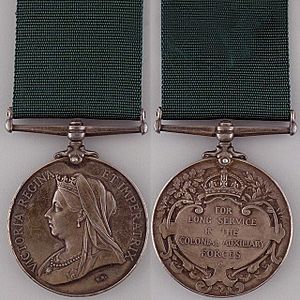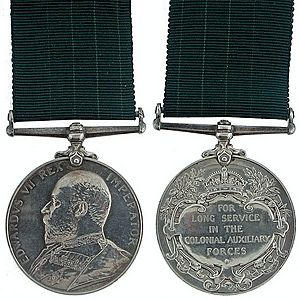Colonial Auxiliary Forces Long Service Medal facts for kids
Quick facts for kids Colonial Auxiliary Forces Long Service Medal |
|
|---|---|

Queen Victoria version
|
|
| Country | |
| Type | Military long service medal |
| Eligibility | All ranks of part-time Colonial Forces |
| Awarded for | Twenty years service |
| Status | Discontinued in 1930 |
| Statistics | |
| Established | 1899 |
| Order of Wear | |
| Next (higher) | Colonial Auxiliary Forces Officers' Decoration |
| Next (lower) | Medal for Good Shooting (Naval) |
| Related | Volunteer Long Service Medal for India and the Colonies |
Ribbon bar |
|
The Colonial Auxiliary Forces Long Service Medal was a special award created by Queen Victoria in 1899. It was given to people who served for a long time in the part-time military groups of the British Colonies, Dependencies, and Protectorates around the world.
This medal was designed to recognize the dedication of soldiers, sailors, and air force members who were not full-time military personnel. It slowly replaced an older medal called the Volunteer Long Service Medal for India and the Colonies in most of these areas. However, it was not used in the Isle of Man, Bermuda, or the Indian Empire.
In 1930, this medal and several others were replaced by a new award called the Efficiency Medal. This change was made to make the awards for part-time service more consistent across the entire British Empire.
Contents
What Was the Medal For?
The Colonial Auxiliary Forces Long Service Medal was created because there was a need to recognize long service in the part-time military forces of the British Empire. Before this medal, a similar award, the Volunteer Long Service Medal, was given to volunteers in the United Kingdom starting in 1894.
In 1896, Queen Victoria decided that members of Volunteer Forces throughout the British Empire should also receive recognition. This led to the creation of the Volunteer Long Service Medal for India and the Colonies.
When Was the Medal Started?
The Colonial Auxiliary Forces Long Service Medal was officially started by Queen Victoria on May 18, 1899. This medal could be given to part-time members of all ranks. This included those in military groups in places like the Dominion of Canada, the Crown Colonies, and the Protectorates. These groups might have been called militia or volunteers.
The medal took over from the Volunteer Long Service Medal for India and the Colonies in most of these territories. However, it did not replace it in the Isle of Man, Bermuda, or the Indian Empire. Different colonies adopted the medal at different times. For example, in what is now Union of South Africa, the Colony of Natal started using it in 1900. Cape of Good Hope followed in 1901, and the Transvaal Colony in 1906. Canada and New Zealand approved the medal in 1902.
How to Earn the Medal
To earn the Colonial Auxiliary Forces Long Service Medal, a person needed to serve for twenty years as a part-time member. This service could be in any rank within the Colonial Auxiliary Forces. It was even possible to combine service from different Colonies or Protectorates.
Service in the Militia and Volunteer Forces of the United Kingdom also counted. However, at least half of the total service had to be in the forces of the Dominions, Colonies, or Protectorates. Interestingly, service on the West Coast of Africa counted as double time, meaning each year there counted as two years towards the medal. Service on the permanent staff (full-time roles) did not count.
If an officer already had this medal and later received the Colonial Auxiliary Forces Officers' Decoration, they did not have to give up the medal. However, they were not allowed to wear both until they had completed enough service for both awards.
In 1923, the rules were updated for part-time members who had served outside their home territories during the First World War. Any active service during the war, whether in the Naval, Military, or Air Forces, counted as double time towards the twenty years needed for the medal.
How Medals Are Worn
Medals are worn in a specific order, which is set by the British Central Chancery of the Orders of Knighthood. The Colonial Auxiliary Forces Long Service Medal was worn after the Colonial Auxiliary Forces Officers' Decoration and before the Medal for Good Shooting (Naval).
Medals in South Africa
In South Africa, a new set of decorations and medals was introduced on April 6, 1952. These new awards replaced the British ones that had been used before. However, older British medals that applied to South Africa continued to be worn. They were worn in the same order but came after all the new South African decorations and medals. The only exception was the Victoria Cross, which always came first.
What the Medal Looked Like
The medal was made of silver and shaped like a disk, about 1.42 inches across. It had a raised edge on both sides. The medal hung from a straight, swiveling silver bar.
Front Side (Obverse)
The front of the medal showed the picture of the reigning monarch. There were three different versions of the medal, depending on who was king or queen at the time.
- The first version, from 1899, featured Queen Victoria. She was shown wearing a crown and veil, looking to the left. Around her picture were the words "VICTORIA REGINA ET IMPERATRIX" (Victoria, Queen and Empress). The initials "TB" of the artist, Sir Thomas Brock, were below her picture.
- After 1901, the King Edward VII version was introduced. It showed him in a Field Marshal's uniform, also looking to the left. The words around his picture were "EDWARDVS VII REX IMPERATOR" (Edward VII, King and Emperor). The artist's initials "DES" (for George William de Saulles) were below his picture.
- The King George V version came out after 1910. It showed him in a Field Marshal's uniform, looking to the left. The words around his picture were "GEORGIVS V BRITT: OMN: REX ET IND: IMP:" (George V, King of all Britons and Emperor of India). The initials "BM" of the Australian artist, Sir Edgar Bertram Mackennal, were under his shoulder.
Back Side (Reverse)
The back of the medal had a decorative shield. On the shield, it said "FOR LONG SERVICE IN THE COLONIAL AUXILIARY FORCES" in five lines. Above the shield was the Imperial Crown, with oak leaves on the left and laurel leaves on the right.
The Ribbon
The ribbon for the medal was plain dark green and about 1.25 inches wide. This same ribbon was used for several other medals, including the Volunteer Long Service Medal and the Colonial Auxiliary Forces Officers Decoration.
When the Medal Ended
The Colonial Auxiliary Forces Long Service Medal, along with several other long service medals, was replaced by the Efficiency Medal on September 23, 1930. This was done to create one standard medal for recognizing part-time military service across the entire British Empire.





